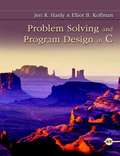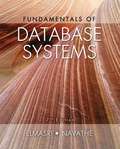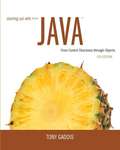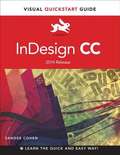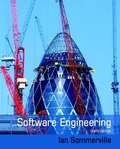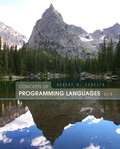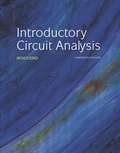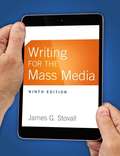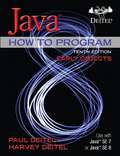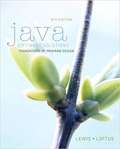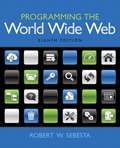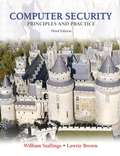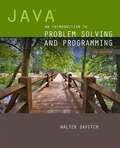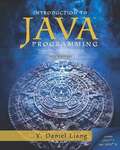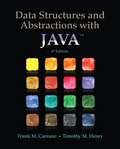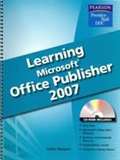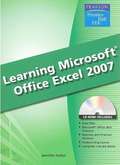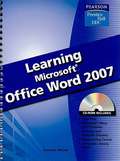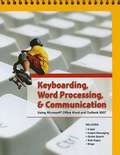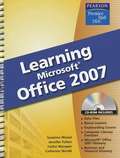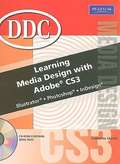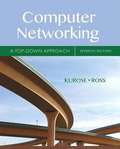- Table View
- List View
Problem Solving And Program Design In C
by Jeri Hanly Elliot KoffmanProblem Solving and Program Design in C teaches readers to program with ANSI-C, a standardized, industrial-strength programming language known for its power and probability. The text uses widely accepted software engineering methods to teach readers to design cohesive, adaptable, and reusable program solution modules with ANSI-C. Through case studies and real world examples, readers are able to envision a professional career in programming.
Fundamentals Of Database Systems
by Ramez Elmasri Shamkant B. NavatheFor database systems courses in Computer Science This book introduces the fundamental concepts necessary for designing, using, and implementing database systems and database applications. Our presentation stresses the fundamentals of database modeling and design, the languages and models provided by the database management systems, and database system implementation techniques. The book is meant to be used as a textbook for a one- or two-semester course in database systems at the junior, senior, or graduate level, and as a reference book. The goal is to provide an in-depth and up-to-date presentation of the most important aspects of database systems and applications, and related technologies. It is assumed that readers are familiar with elementary programming and data-structuring concepts and that they have had some exposure to the basics of computer organization.
Starting Out with Java: From Control Structures through Objects
by Tony GaddisFor courses in computer programming in Java Starting Out with Java: From Control Structures through Objects provides a brief yet detailed introduction to programming in the Java language. Starting out with the fundamentals of data types and other basic elements, readers quickly progress to more advanced programming topics and skills. By moving from control structures to objects, readers gain a comprehensive understanding of the Java language and its applications. As with all Gaddis texts, the Sixth Edition is clear, easy to read, and friendly in tone. The text teaches by example throughout, giving readers a chance to apply their learnings by beginning to code with Java.
Visual Quickstart Guide: Indesign CC (2014 Release for Windows and MacIntosh)
by Sandee CohenInDesign CC: Visual QuickStart Guide (2014 release) is your complete guide to the core functions of InDesign as well as all the important new features. New to this edition is coverage of the greatly expanded ebook export capabilities, including Fixed Layout EPUB. With the growth in digital publishing, these new functions will empower designers to create more compelling digital documents than ever before. Other landmark new features in the 2014 release of InDesign CC include: the ability to reformat tables by dragging and dropping; integration with the hot portfolio site, Behance, and improvements to footnotes. Using the task-based, visual approach that is the trademark of the Visual QuickStart Guides readers will learn not only how to create documents, but also to use automation to streamline the process, as well as importing and styling text and objects, managing long documents, exporting files for a wide variety of purposes, and much more.
Software Engineering
by Ian SommervilleThe Fundamental Practice of Software Engineering Software Engineering introduces readers to the overwhelmingly important subject of software programming and development. In the past few years, computer systems have come to dominate not just our technological growth, but the foundations of our world’s major industries. This text seeks to lay out the fundamental concepts of this huge and continually growing subject area in a clear and comprehensive manner. The Tenth Edition contains new information that highlights various technological updates of recent years, providing readers with highly relevant and current information. Sommerville’s experience in system dependability and systems engineering guides the text through a traditional plan-based approach that incorporates some novel agile methods. The text strives to teach the innovators of tomorrow how to create software that will make our world a better, safer, and more advanced place to live.
Concepts of Programming Languages (Eleventh Edition)
by Robert W. SebestaFor courses in computer programming. Concepts of Computer Programming Languages introduces students to the fundamental concepts of computer programming languages and provides them with the tools necessary to evaluate contemporary and future languages. An in-depth discussion of programming language structures, such as syntax and lexical and syntactic analysis, also prepares readers to study compiler design. The Eleventh Edition maintains an up-to-date discussion on the topic with the removal of outdated languages such as Ada and Fortran. The addition of relevant new topics and examples such as reflection and exception handling in Python and Ruby add to the currency of the text. Through a critical analysis of design issues of various program languages, Concepts of Computer Programming Languages teaches programmers the essential differences between computing with specific languages.
Introductory Circuit Analysis
by Robert L. BoylestadFor courses in DC/AC circuits: conventional flow The Latest Insights in Circuit Analysis Introductory Circuit Analysis, the number one acclaimed text in the field for over three decades, is a clear and interesting information source on a complex topic. The Thirteenth Edition contains updated insights on the highly technical subject, providing readers with the most current information in circuit analysis. With updated software components and challenging review questions at the end of each chapter, this text engages readers in a profound understanding of Circuit Analysis.
The Best Interface Is No Interface: The Simple Path to Brilliant Technology
by Golden KrishnaOur love affair with the digital interface is out of control. We've embraced it in the boardroom, the bedroom, and the bathroom. Screens have taken over our lives. Most people spend over eight hours a day staring at a screen, and some "technological innovators" are hoping to grab even more of your eyeball time. You have screens in your pocket, in your car, on your appliances, and maybe even on your face. Average smartphone users check their phones 150 times a day, responding to the addictive buzz of Facebook or emails or Twitter. Are you sick? There's an app for that! Need to pray? There's an app for that! Dead? Well, there's an app for that, too! And most apps are intentionally addictive distractions that end up taking our attention away from things like family, friends, sleep, and oncoming traffic. There's a better way. In this book, innovator Golden Krishna challenges our world of nagging, screen-based bondage, and shows how we can build a technologically advanced world without digital interfaces. In his insightful, raw, and often hilarious criticism, Golden reveals fascinating ways to think beyond screens using three principles that lead to more meaningful innovation. Whether you're working in technology, or just wary of a gadget-filled future, you'll be enlighted and entertained while discovering that the best interface is no interface.
Writing For The Mass Media (Ninth Edition)
by James G. StovallA clear and effective introduction to media writing Writing for the Mass Media offers clear writing, simple organization, abundant exercises, and precise examples that give students information about media writing and opportunities to develop their skills as professional writers. With a focus on a converged style of media writing, and converting that style into real work, this ninth edition maintains its classic and effective text/workbook format while staying ahead of the curve and preparing students for their future careers. MyCommunicationLab is an integral part of the Stovall program. MediaShare allows students to post speeches and share them with classmates and instructors. Interactive videos provide students with the opportunity to watch and evaluate sample speeches. Online self-assessments and pre- and post-tests help students assess their comfort level with public speaking and their knowledge of the material.
Java How To Program: Early Objects
by Paul Deitel Harvey DeitelJava How to Program (Early Objects) , Tenth Edition is intended for use in the Java programming course. It also serves as a useful reference and self-study tutorial to Java programming. The Deitels' groundbreaking How to Program series offers unparalleled breadth and depth of object-oriented programming concepts and intermediate-level topics for further study.
Java Software Solutions
by John Lewis William LoftusJava Software Solutions teaches a foundation of programming techniques to foster well-designed object-oriented software. Heralded for its integration of small and large realistic examples, this worldwide best-selling text emphasizes building solid problem-solving and design skills to write high-quality programs.
Programming the World Wide Web (Eighth Edition )
by Robert W. SebestaProgramming the World Wide Web is intended for undergraduate students who have completed a course in object-oriented programming. It also serves as an up-to-date reference for Web programming professionals. Programming the World Wide Web provides a comprehensive introduction to the tools and skills required for both client- and server-side programming, teaching students how to develop platform-independent sites using the most current Web development technology.
Computer Security: Principles and Practice
by William Stallings Lawrie BrownComputer Security: Principles and Practice, Third Edition, is ideal for courses in Computer/Network Security. It also provides a solid, up-to-date reference or self-study tutorial for system engineers, programmers, system managers, network managers, product marketing personnel, system support specialists. In recent years, the need for education in computer security and related topics has grown dramatically--and is essential for anyone studying Computer Science or Computer Engineering. This is the only text available to provide integrated, comprehensive, up-to-date coverage of the broad range of topics in this subject In addition to an extensive pedagogical program, the book provides unparalleled support for both research and modeling projects, giving students a broader perspective It covers all security topics considered Core in the EEE/ACM Computer Science Curriculum. This textbook can be used to prep for CISSP Certification, and includes in-depth coverage of Computer Security, Technology and Principles, Software Security, Management Issues, Cryptographic Algorithms, Internet Security and more. The Text and Academic Authors Association named Computer Security: Principles and Practice, First Edition, the winner of the Textbook Excellence Award for the best Computer Science textbook of 2008. Teaching and Learning Experience This program presents a better teaching and learning experience--for you and your students. It will help: Easily Integrate Projects in your Course: This book provides an unparalleled degree of support for including both research and modeling projects in your course, giving students a broader perspective Keep Your Course Current with Updated Technical Content: This edition covers the latest trends and developments in computer security. Enhance Learning with Engaging Features: Extensive use of case studies and examples provides real-world context to the text material. Provide Extensive Support Material to Instructors and Students: Student and instructor resources are available to expand on the topics presented in the text.
Java: An Introduction to Problem Solving and Programming (Seventh Edition)
by Walter SavitchAn introduction to programming using the Java computer programming language.
Introduction to Java Programming, Comprehensive Version
by Y. Daniel LiangThis text is intended for a 1-, 2-, or 3-semester CS1 course sequence. Comprehensive coverage of Java and programming make this a useful reference for beginning programmers and IT professionals. Daniel Liang teaches concepts of problem-solving and object-oriented programming using a fundamentals-first approach. Beginning programmers learn critical problem-solving techniques then move on to grasp the key concepts of object-oriented, GUI programming, advanced GUI and Web programming using Java. Liang approaches Java GUI programming using JavaFX, not only because JavaFX is much simpler for new Java programmers to learn and use but because it has replaced Swing as the new GUI tool for developing cross-platform-rich Internet applications on desktop computers, on hand-held devices, and on the Web.
Data Structures and Abstractions with Java (Fourth Edition)
by Frank M. Carrano Timothy M. HenryA book for an introductory course in data structures, typically known as CS-2.
Learning Microsoft Office Excel 2007
by Jennifer FultonKey Benefit:DDC Learning Microsoft Office Excel 2007simplifies the new Office 2007 user interface and powerful new features of Excel. Hands-on exercises and applications provide a practical, effective approach to learning software skills. Key Topics: Covers the features of the application, step-by-step, including expanded coverage of graphics and integration with other Office applications, as well as all Microsoft Certified Application Specialist objectives. Market: For anyone looking to learn MS Office Excel.
Prentice Hall Technology Education: Learning by Design, Revised Edition
by Michael Hacker Dave BurghardtNIMAC-sourced textbook
Keyboarding, Word Processing, & Communication: Using Microsoft® Office Word and Outlook 2007
by Pearson EducationNIMAC-sourced textbook
Learning Computers and Technology
by Suzanne Weixel Jennifer Fulton Lisa A. BuckiNIMAC-sourced textbook
Learning Microsoft Office 2007
by Suzanne Weixel Jennifer Fulton Faithe Wempen Catherine SkintikAre you a visual learner? Do you prefer instructions that show you how to do something - and skip the long-winded explanations? If so, then this book is for you. Open it up, and you will find clear, step-by-step screen shots that show you how to tackle more than 170 Access 2007 tasks. Each task-based spread includes easy, visual directions for performing necessary operations, including * Navigating the new interface * Using templates to create databases * Entering and editing data * Working with tables and fields * Creating simple or summary queries * Linking to Excel(r) worksheets * Helpful sidebars offer practical tips and tricks * Full-color screen shots demonstrate each task * Succinct explanations walk you through step by step * Two-page lessons break big topics into bite-sized modules
Computer Networking: A Top-down Approach
by James Kurose Keith RossComputer Networking: A Top-Down Approach Featuring the Internet
